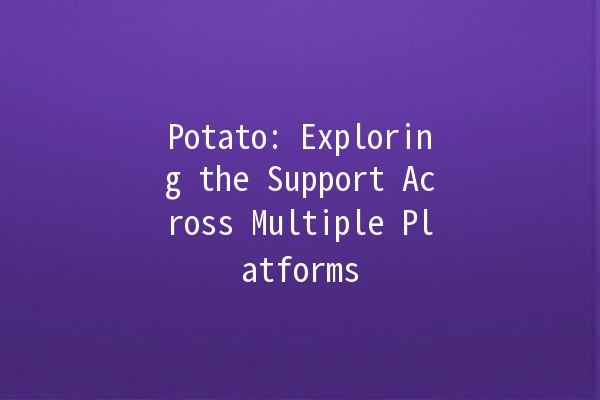to Potato and Its MultiPlatform Support
In today's rapidly evolving digital world, the way we engage with software and applications is increasingly important. One application that has gained significant attention in several tech circles is Potato. This versatile app is designed to streamline various processes, notably in productivity and development.
The significance of understanding the multiplatform support of Potato cannot be overstated, especially for users looking to enhance their productivity. This article delves deep into the various platforms compatible with Potato, as well as offering practical tips for users aiming to maximize their experience.
Understanding MultiPlatform Support
Multiplatform support refers to software applications being available on various operating systems and environments, such as Windows, macOS, Linux, Android, and iOS. This adaptability allows users to seamlessly switch between devices without losing functionality or progress.
The ability of Potato to operate across multiple platforms ensures that users can enjoy the app's features regardless of their preferred devices. This is particularly useful for professionals and teams who frequently switch between PCs and mobile devices.

Platforms Supported by Potato
Boosting Productivity with Potato: Five Essential Tips
As users engage with Potato on various platforms, several strategies can enhance productivity. Here are five effective tips:
Explanation: Always ensure that your Potato account is synchronized across all devices. This way, any changes made on one platform immediately reflect on another.
Example: If you are working on a project on your Windows laptop, and you need to leave but want to continue on your iPhone, syncing ensures that you have access to the most uptodate version of your work.
Explanation: Like many productivity applications, Potato supports numerous keyboard shortcuts, which can significantly speed up workflow.
Example: Familiarizing yourself with common shortcuts will save time. For instance, using "Ctrl + N" for creating a new document can help bypass the clutter of navigating through menus.
Explanation: Take advantage of Potato’s organizational features, such as tags and categories, to keep your projects and notes structured.
Example: If you're managing multiple projects, categorizing them under specific tags (e.g., "Marketing," "Development," etc.) will streamline your access to relevant information.
Explanation: Potato is designed to work well with other applications, enabling the sharing of data between software.
Example: Integrating with tools like Google Drive or Trello may optimize project management. For instance, organizing your tasks in Trello and referencing them in Potato could streamline your workflow.
Explanation: Keeping Potato updated ensures that you have access to the latest features and security improvements.
Example: Regular updates may introduce helpful tools or performance boosts that enhance usability. Enabling autoupdates on your devices can simplify this process.
Common Questions About Potato MultiPlatform Support
Potato is designed to be compatible with a wide range of devices, including Windows PCs, Mac computers, Linux systems, Android tablets, mobile phones, and it also has a responsive web application for added accessibility.
Yes, Potato supports automatic data synchronization across platforms. Users need to ensure they are logged into the same account on all devices for this feature to work effectively. Changes made on one device will be reflected on others in realtime.
While Potato offers many features online, certain functionalities may require an internet connection for synchronization and updates. However, the desktop versions allow for offline work, and any changes made will sync once the connection is restored.
The mobile versions of Potato provide a streamlined experience, although some advanced features might be limited compared to desktop versions. Still, core functionalities are accessible, ensuring that productivity is maintained on the go.
Yes, you can use Potato on multiple devices simultaneously. For instance, you can work on a document on your laptop while reviewing it on your tablet. Just make sure all devices are synchronized.
Potato stands out by offering an extensive range of features that cater to various professional needs. Additionally, its strong multiplatform support ensures that users can shift between devices without losing progress or functionality.
Enhancing User Experience Further
As advances in technology continue to emerge, users should proactively engage with the features Potato offers across multiple platforms. Participating in community forums and feedback sessions can provide constructive insights that may contribute to future updates.
Understanding how to leverage Potato's capabilities will not only boost individual productivity but may also enhance collaboration within teams. Whether filtering through apps on a mobile device, engaging in detailed project management on a desktop, or leveraging web access for remote work, Potato is a vital tool in today’s dynamic work environment.
, the versatility of Potato in supporting multiple platforms positions it as an indispensable tool for enhancing productivity. With practical tips and an understanding of its functionalities, users can maximize their efficiency and redefine how they manage their tasks across devices.